| Biological resources or biodiversity are crucial for the development of poor countries in the tropics. Native plants and animals are particularly important to peasant and indigenous populations in rural areas; these people often depend directly on harvesting local species for their daily needs such as energy (fire-wood), food, medicine, and construction material. | 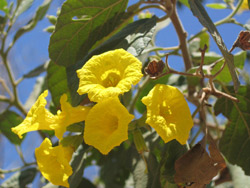 |
||||||||||||
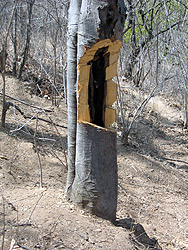 |
|||||||||||||
| Flowers of Cordia lutea, a common tree with many local uses | |||||||||||||
| Sustainable management of biological resources may therefore contribute significantly to economic development and improved livelihoods for rural people, but currently the biodiversity of poor tropical countries are often under severe stress or even in danger of irreplaceable loss. | |||||||||||||
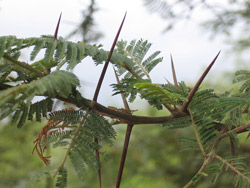 |
|||||||||||||
| Tree that has served to extract honey | |||||||||||||
|
The overall objective af this project is to facilitate that local flora and fauna may persist and support economic development and the well-being in The Andean region is extremely rich in biological resources, but at the same time and compared to other tropical areas it is poorly known. |
|||||||||||||
| Spines af Acasia macracantha, a dominant tree in the dry forest in Southern Ecuador | |||||||||||||
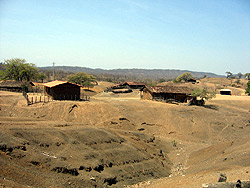 |
Their natural resources suffer from unsustainable use-practices, but still extensive expanses of intact ecosystems remain which makes it feasible to preserve and manage much of their original biodiversity. Basic research that is needed to take advantage of the two countries’ biodiversity began only decades ago. The biodiversity of |
||||||||||||
| Village in eroded landscape in Southern Ecuador | |||||||||||||
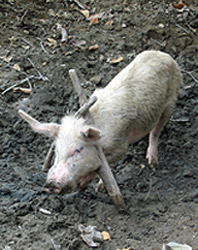 |
|||||||||||||
| The project is built around research concerning economically important species, and it produces inventories of useful species, and studies of their potential for exploitation and sustainable management, as well as their ecology, variation and distribution. | |||||||||||||
| A transversal priority is to ensure Bolivia and Ecuador access to international printed and electronic biodiversity information, particularly linking the participating institutions with the Global Biodiversity Information Facility (GBIF) and the Andinonet initiative recently established in the region, as well as to the Regional Strategy of Biodiversity Conservation. | |||||||||||||
| Pig with branches of Pisonia aculeata preventing it from passing a fence | |||||||||||||
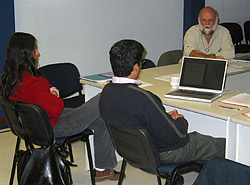 |
|||||||||||||
| The project intends to demonstrate that developing countries can participate in and benefit from global networking projects such as the GBIF-initiative, Andinonet, and the projects’ ambition is to serve as a model for an equal and active collaboration between industrialized and developing countries in biodiversity research and informatics. | |||||||||||||
| Project workshop | |||||||||||||
Dissemination Strategy
| This project intends to improve the participating institutions capacity to produce and capture relevant biodiversity related information, process it and make it available to a broad range of users in the private and public sector. | ||||||||||
|
The intended users include local communities of peasants and indigenous people who wish to use plant and animal species of their surroundings in a sustainable way, government authorities who protect and manage of natural biological resources, local industries that produce plant or animal-derived products such as human or veterinary medicines, local NGO’s who carry out community projects with biodiversity components, forestry projects that need exact identification of their tree species to access biological information, etc. |
||||||||||
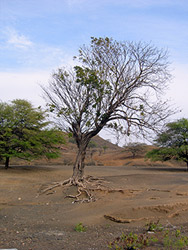 |
||||||||||
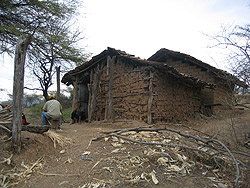 |
||||||||||
| Loxoptorygium huasango tree with visible root system due to erosion | ||||||||||
| The trained biodiversity workers and researchers will be intermediaries between those who use and those who produce and manage biodiversity information. | ||||||||||
| Interview with local peasant in front of his house in Southern Ecuador | ||||||||||
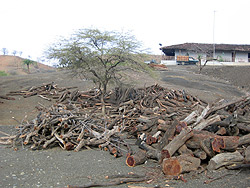 |
||||||||||
|
The expected long term outcome is that the involved institutions will have the capacity to contribute to a wiser use of their countries' biological resources and that these resources will be protected from destruction and made available to poor rural populations as well as industries that contribute to the economic development of the countries. Results will be disseminated via the national and international journals, conference presentations, lectures, workshops, etc. |
||||||||||
| Wood, mostly from Prosopis juliflora, cut for fences and firewood | ||||||||||
Organisation and financial management
| The project is managed principally by the Danish Research Institution, at the |
||||||||
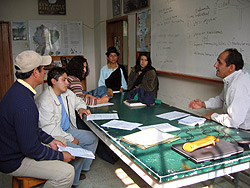 |
||||||||
| Loja group in herbarium with director Zhofre Aguirre talking to students | ||||||||
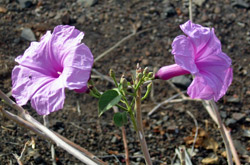 |
||||||||
|
A Steering Committee oversees the project, review yearly plans for upcoming activities and yearly reports of past activities for each of the involved institutions. The Steering Committee reports its approval of, or concerns about, these plans and reports to the project director, professor Henrik Balslev, who is responsible to the funding agency, Danida. |
||||||||
| Ipomoea carnea, a dominant species in most degraded areas. | ||||||||